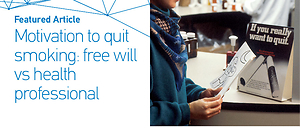Dear Editor,
As a complement to a previous study by our group whose data and methodology have already been published1,2, we hypothesize that the motivation to quit smoking could be greater if the subject is going to quit smoking of their own free will (OFW) than if they are sent on the advice of a health professional.
The aim of the study was to check whether the degree of motivation to quit smoking is different depending on who refers the smoker to the smoking treatment consultation, considering three sources of remission (variable ‘referred by’): primary care (PC), medical specialist (OS) or by OFW.
For this analysis, the subjects finally included were 292 [72.1%; 155 women (53.1%); mean age 51.1 ± 11.0 years (range: 25–77)]. Ninety-nine subjects (33.9%) attended our smoking clinics on PC advice, 116 (29.7%) subjects on OS advice, and 77 subjects (26.4%) on OFW. We have used four motivational tests to quit smoking (MTQS): Richmond Test (RT), the Henri Mondor Paris Motivation Test (HMPMT), Khiwji-Watts test (KWT) and the visual analogue scale (VAS)1.
Supplementary file Table 1 shows the distribution of the three categories of the variable ‘referred by’ for all participants and by sex, and we found no significant differences. Table 1 shows the mean age values for all participants, by sex, and by each category of the variable ‘referred by’. There were no statistically significant differences between the mean ages of the different categories. Table 1 also shows the mean values of the scores of the MTQS according to the categories of the variable ‘referred by’, for all participants and by sex. Only in the HMPMT were there significant differences between PC versus OS, but this was only for men.
Table 1
Description of the quantitative variables for all participants, by sex, and by ‘referred by’
| Characteristics | All | Males | Females | p |
|---|---|---|---|---|
| Total, n | 292 | 137 | 155 | |
| Age (years), mean ± SD (range) | 51.1 ± 11.0 (25–77) | 51.5 ± 11.1 (27–77) | 50.7 ± 10.9 (25–76) | 0.522 |
| Referred by | Primary Care | Other Specialties | Own Free-Will | p |
| Total, n | ||||
| All | 99 | 116 | 77 | |
| Males | 45 | 61 | 31 | |
| Females | 54 | 55 | 46 | |
| Age (years), mean ± SD (range) | ||||
| All | 50.0 ± 10.9 (29–77) | 53.0 ± 10.9 (25–77) | 48.7 ± 10.9 (26–72) | 0.084 |
| Males | 51.4 ± 11.0 (29–77) | 53.6 ± 10.6 (28–77) | 47.8 ± 11.7 (27–66) | 0.122 |
| Females | 48.9 ± 10.8 (29–70) | 52.3 ± 11.3 (25–76) | 50.9 ± 10.3 (26–72) | 0.248 |
| Motivation scales (scores), mean ± SD (range) | ||||
| All | ||||
| RT | 7.9 ± 1.6 (3–10) | 7.8 ± 1.5 (4–10) | 8.2 ± 1.4 (5–10) | 0.340 |
| HMPMT | 13.8 ± 2.4 (6–18) | 12.6 ± 2.7 (3–18) | 13.5 ± 2.9 (5–18) | 0.003 |
| KWT | 11.6 ± 2.6 (5–15) | 11.2 ± 2.6 (5–15) | 11.7 ± 2.4 (7–15) | 0.302 |
| VAS | 8.1 ± 1.8 (0–10) | 7.7 ± 2.1 (0–10) | 8.2 ± 1.7 (0–10) | |
| MD (SE) (95% CI)* | 1.2 (0.4) (0.3–2.1) | |||
| Males | ||||
| RT | 7.9 ± 1.6 (3–10) | 7.9 ± 1.5 (4–10) | 8.5 ± 1.3 (6–10) | 0.122 |
| HMPMT | 14.2 ± 2.3 (10–18) | 12.7 ± 2.7 (7–18) | 13.5 ± 3.1 (7–18) | 0.021 |
| KWT | 11.3 ± 2.6 (7–15) | 10.9 ± 2.6 (5–15) | 12.3 ± 2.6 (7–15) | 0.054 |
| VAS | 8.3 ± 1.9 (0–10) | 7.9 ± 1.9 (2–10) | 8.5 ± 1.6 (4–10) | 0.216 |
| MD (SE) (95% CI)* | 1.5 (0.5) (0.2–2.8) | |||
| Females | ||||
| RT | 7.9 ± 1.7 (4–10) | 7.8 ± 1.6 (4–10) | 7.9 ± 1.4 (5–10) | 0.890 |
| HMPMT | 13.4 ± 2.5 (6–18) | 12.4 ± 2.8 (3–18) | 13.5 ± 2.7 (5–18) | 0.068 |
| KWT | 11.8 ± 2.7 (5–15) | 11.5 ± 2.7 (5–15) | 11.3 ± 2.3 (7–15) | 0.475 |
| VAS | 8.0 ± 1.7 (3–10) | 7.5 ± 2.3 (0–10) | 8 ± 1.7 (0–10) | 0.733 |
A previous study concluded that smoking cessation is motivated by concern for self-health and family’s health, family’s support, and social pressures3. In some studies, promptings by doctors were reported as being a reason for quitting by only 13% of respondents, and only one quarter of respondents received cessation-related awareness from their doctors4. It is known that personal willpower is an essential feature of the 5As model in ‘Treating Tobacco Use and Dependence’5, of which the first three As build towards willingness to quit and the last two As facilitate those willing to quit to take the final decision to quit5. This suggests how personal motivation that arises from within the individual is more likely to lead to successful cessation than when it arises externally3, but also, it is known, that a specific referral to a smoking cessation program can increase participation by patients6,7.
So, we cannot demonstrate differences in the scores of the analyzed smoking cessation motivation scales depending on who refers the subject. Subjects who attend smoking cessation clinics of their OFW do not have higher scores on the motivation questionnaires used when compared to those who attend on the advice of their PC or OS.


